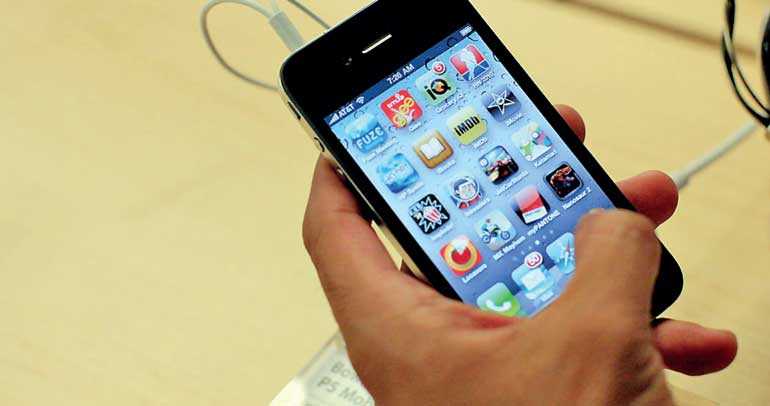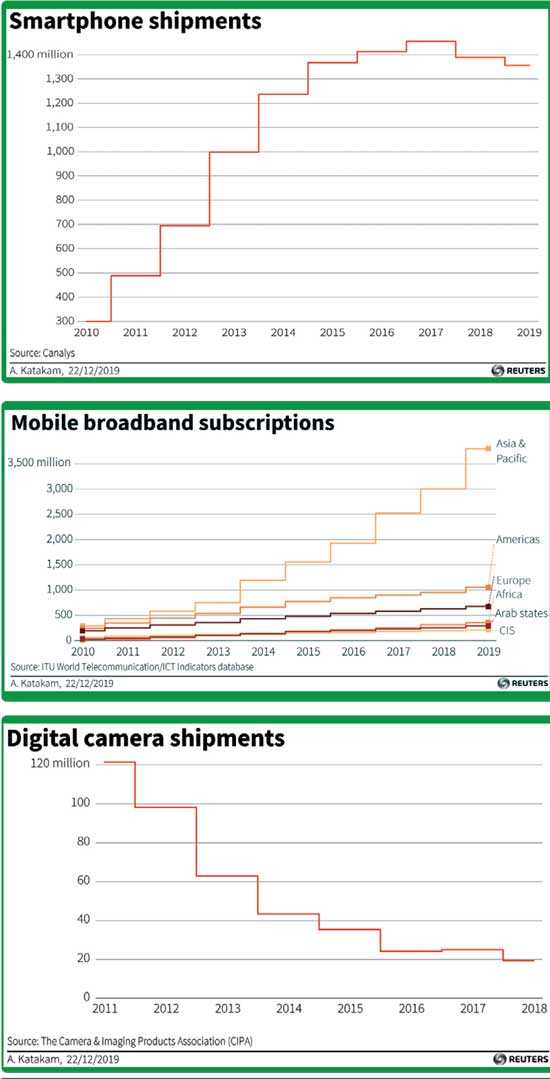Thursday Feb 27, 2025
Thursday Feb 27, 2025
Thursday, 2 January 2020 02:54 - - {{hitsCtrl.values.hits}}

A customer looks at an iPhone 4 at the Apple Store 5th Avenue in New York, in this 24 June 2010 - Reuters/ File photo
Reuters: When the first Apple iPhone hit the market in 2007, not everyone was convinced it would supplant the flip-phone. When Google’s Android software system arrived a year later, the Blackberry still seemed to have bright future.
But with the iPhone 4 in 2010, featuring a high-resolution display, sleek design and front-facing camera, our collective fate was sealed. Here are 10 ways the smartphone has made its mark over the decade.
Today some 5 billion smartphones are in use around the world, according to Canalys Research. The total number of internet subscriptions has soared to 7.2 billion globally from 1.3 billion in 2010, the vast majority of them mobile subscriptions, International Telecommunications Union data shows. The explosion in connectivity has been especially dramatic in the developing world, where there are now more mobile connections than people. 
Apple Inc. (AAPL.O), once a niche computer company, is now one of the world’s most valuable companies thanks to the iPhone. The five largest Fortune 500 technology companies - Apple, Amazon, Google, Microsoft and Facebook - currently boast a market cap of $4.7 trillion, compared with about $800 billion for the top five in 2010. Not all of that is due to the smartphone, of course, but the mobile-related technologies and services accounted for nearly $4 trillion in economic activity in 2018, according to trade group GSMA.
Whether we’re hailing a cab, ordering food, playing a game, finding a date, listening to music or shopping for just about anything, there’s a good chance we’ll be doing it with a smartphone app that didn’t exist in 2010. Many of most popular apps are free, but consumers are still expected to spend more than $120 billion in app stores during 2019, according to App Annie, a mobile apps analytics firm.
The endless scroll on Facebook, Instagram, Twitter (TWTR.N) and other social media apps now consumes 34 minutes of every US adult’s day, according to Nielsen. Fewer people are sitting on the sofa to watch live TV at set times, and advertisers are following. Mobile ad spending surpassed TV for the first time in 2018 in terms of percentage share of the US market, according to research firm eMarketer. We can also thank the smartphone for Instagram influencers, “sextortion,” and fake news.
Global shipments of digital cameras dropped from their 2010 peak of 121 million to just 19 million units in 2018, according to the Camera & Imaging Products Association (CIPA). Meantime the latest phones pack as many four camera lenses and cutting edge software that makes it easier than ever to get that perfect shot. The front-facing camera might be the busiest: Google reports that its Android devices take 93 million selfies every day.
The satellite tracking technology known as GPS, combined with information from cell towers and Wi-Fi networks, has made the smartphones incredibly powerful tracking devices. Google maps and its poorer cousins enable even the most directionally impaired find their way around unfamiliar locales with ease.
For the privacy-minded, though, it’s a disaster: Phone companies and app makers routinely record the movements of subscribers and sell that data to advertisers, a $20 billion-a-year business. The data is “anonymised,” but as numerous studies and a recent New York Times investigation have revealed it is often a simple matter to identify who is behind the dot on the map. Nearly 50% of companies surveyed by Verizon this year used or planned to soon use smartphone management tools to track their employees.
The 2010 edition of the venerable Encyclopaedia Britannica, all 32 volumes and 129 pounds of it, turned out to be the last. But untold barroom arguments or dining room debates can now be settled on the spot: Wikipedia is consulted more than 240 million times daily.
In 2018 alone in the United States, 2,628 fatal crashes involved a distracted driver, and of those deadly crashes, about 13% involved mobile phone use, according to the National Highway Traffic Safety Administration (NHTSA).
Discover Kapruka, the leading online shopping platform in Sri Lanka, where you can conveniently send Gifts and Flowers to your loved ones for any event including Valentine ’s Day. Explore a wide range of popular Shopping Categories on Kapruka, including Toys, Groceries, Electronics, Birthday Cakes, Fruits, Chocolates, Flower Bouquets, Clothing, Watches, Lingerie, Gift Sets and Jewellery. Also if you’re interested in selling with Kapruka, Partner Central by Kapruka is the best solution to start with. Moreover, through Kapruka Global Shop, you can also enjoy the convenience of purchasing products from renowned platforms like Amazon and eBay and have them delivered to Sri Lanka.
Discover Kapruka, the leading online shopping platform in Sri Lanka, where you can conveniently send Gifts and Flowers to your loved ones for any event including Valentine ’s Day. Explore a wide range of popular Shopping Categories on Kapruka, including Toys, Groceries, Electronics, Birthday Cakes, Fruits, Chocolates, Flower Bouquets, Clothing, Watches, Lingerie, Gift Sets and Jewellery. Also if you’re interested in selling with Kapruka, Partner Central by Kapruka is the best solution to start with. Moreover, through Kapruka Global Shop, you can also enjoy the convenience of purchasing products from renowned platforms like Amazon and eBay and have them delivered to Sri Lanka.